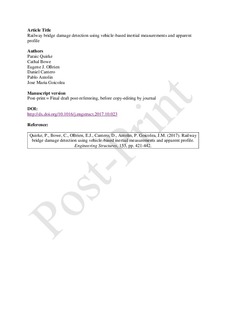| dc.contributor.author | Quirke, Paraic | |
| dc.contributor.author | Bowe, Cathal | |
| dc.contributor.author | OBrien, Eugene J | |
| dc.contributor.author | Cantero, Daniel | |
| dc.contributor.author | Antolin, Pablo | |
| dc.contributor.author | Goicolea, Jose Maria | |
| dc.date.accessioned | 2018-04-04T06:36:47Z | |
| dc.date.available | 2018-04-04T06:36:47Z | |
| dc.date.created | 2017-11-01T09:47:33Z | |
| dc.date.issued | 2017 | |
| dc.identifier.citation | Engineering structures. 2017, 153 421-442. | nb_NO |
| dc.identifier.issn | 0141-0296 | |
| dc.identifier.uri | http://hdl.handle.net/11250/2492433 | |
| dc.description.abstract | The presence of damage in a railway bridge alters its stiffness and consequently, its static and dynamic response to loading. The dynamic response of a railway bridge to loading produces a dynamic response in the passing vehicle, potentially enabling detection of the damage through analysis of the vehicle response. A method is proposed in this paper for the detection of bridge damage through comparison of apparent profiles sensed by the passing vehicle. The apparent profile is a virtual longitudinal profile which, when applied to a vehicle, invokes the same measured response to the crossing of a bridge. A change in the deflection of the bridge due to the presence of damage manifests itself as a change in the apparent profile associated with the measured vehicle response.
The Cross Entropy optimisation method is used in this study to determine the apparent profiles that generate a vehicle dynamic response most similar to that of a measured input. ‘Measured’ bogie vertical acceleration signals are generated using a 3-dimensional train-bridge interaction model implemented in Abaqus and used as input to a 2-dimensional algorithm implemented in Matlab. Damage is introduced to the bridge structure by applying a localised reduction in the width of the bottom flange of a bridge beam, simulating the effect of a sudden impact from a vehicle strike. Apparent profiles for a number of damage scenarios are inferred and compared over time to detect damage. The algorithm is also tested for resilience to sensor noise and effectiveness in the presence of track irregularities. | nb_NO |
| dc.language.iso | eng | nb_NO |
| dc.publisher | Elsevier | nb_NO |
| dc.rights | Attribution-NonCommercial-NoDerivatives 4.0 Internasjonal | * |
| dc.rights.uri | http://creativecommons.org/licenses/by-nc-nd/4.0/deed.no | * |
| dc.title | Railway bridge damage detection using vehicle-based inertial measurements and apparent profile | nb_NO |
| dc.type | Journal article | nb_NO |
| dc.type | Peer reviewed | nb_NO |
| dc.description.version | acceptedVersion | nb_NO |
| dc.source.pagenumber | 421-442 | nb_NO |
| dc.source.volume | 153 | nb_NO |
| dc.source.journal | Engineering structures | nb_NO |
| dc.identifier.doi | 10.1016/j.engstruct.2017.10.023 | |
| dc.identifier.cristin | 1509619 | |
| dc.description.localcode | © 2017. This is the authors’ accepted and refereed manuscript to the article. Locked until 1.11.2019 due to copyright restrictions. This manuscript version is made available under the CC-BY-NC-ND 4.0 license http://creativecommons.org/licenses/by-nc-nd/4.0/ | nb_NO |
| cristin.unitcode | 194,64,45,0 | |
| cristin.unitname | Institutt for konstruksjonsteknikk | |
| cristin.ispublished | true | |
| cristin.fulltext | postprint | |
| cristin.qualitycode | 2 | |

